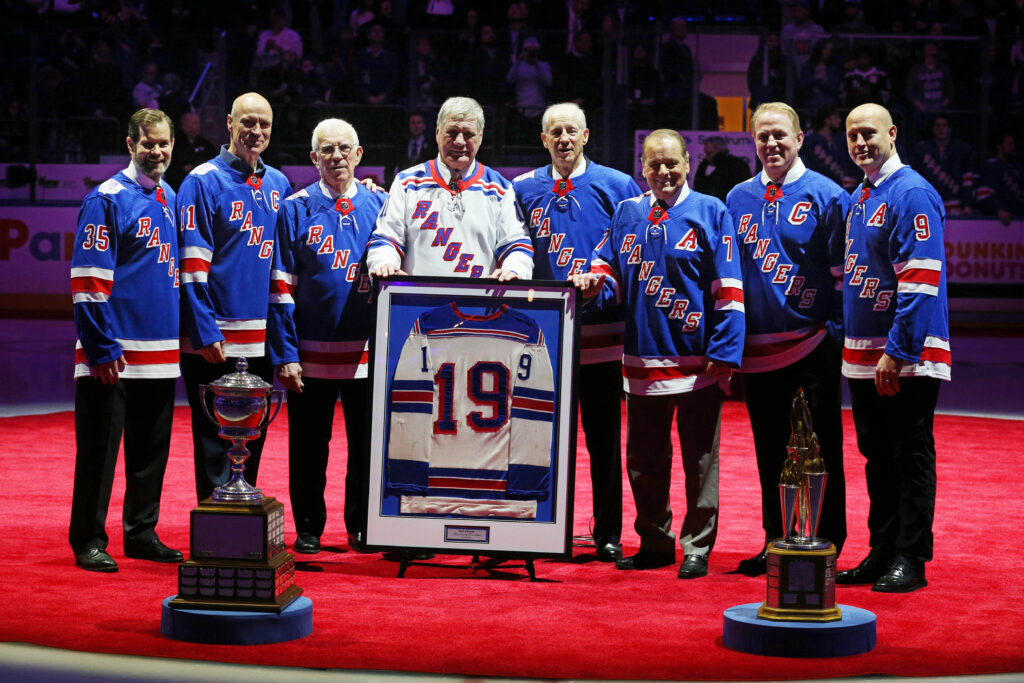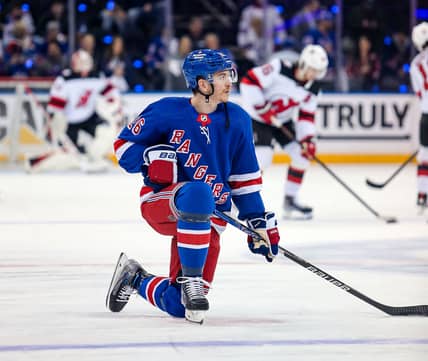Rangers Greatest Hits: Vic Hadfield’s 50-goal season in 1971-72

At the beginning of his career, no one would have expected Vic Hadfield would become the New York Rangers’ first 50-goal scorer. According to his statistics at EliteProspects.com, in juniors, he collected 25 goals in 99 games, instead focusing his efforts on roughing up opponents, earning 202 penalty minutes in two seasons. During his first stint in the minors with the Buffalo Bison, he had just five goals in 63 games, with 111 penalty minutes.
Eventually, Hadfield cracked the Rangers lineup in 1961-62 when he was 21. Statistically, it would take him six seasons in the NHL to break the 20-goal mark and only three seasons to surpass 100 penalty minutes, leading the league with 151 in 1963-64. Interestingly, at the time, those 151 minutes were the third-highest total in team history, behind Lou Fontinato’s total of 206 (1955-56) and 152 (1957-58).
However, things began to change for Hadfield as he found chemistry with teammates Jean Ratelle and Rod Gilbert, who would eventually form the GAG “Goal-A-Game” Line. Ultimately, the trio would end a lengthy playoff drought on Broadway, rewrite the team’s record book, and reenergize a fanbase two decades removed from a Stanley Cup championship.
Thanks to the success of the GAG Line, Hadfield began to routinely score 20 goals a season, setting a career-high of 26 in 1968-69. But, the best was yet to come, as he would become the first player in team history and just the sixth skater in NHL history to net 50 goals in a single campaign.
So, let’s revisit Hadfield’s historic 1971-72 season, where he set a franchise goal-scoring record that remained unmatched for 22 seasons.
Related: History of New York Rangers captains
Vic Hadfield begins historic season by piling up points
The Rangers played 15 games in October 1971, producing a 6-1-4 record, scoring 41 goals and giving up 31. Statistically, Hadfield had 16 points in 11 games with eight goals and assists, accounting for 19% of the team’s goals that month. Additionally, he only had ten penalty minutes and registered a 24.2 shooting percentage.
As the calendar flipped to November, he picked up the pace, potting nine goals and 11 helpers for 20 points in 11 games. Amazingly, he had those totals, including a 25.7 shooting percentage, while collecting 39 penalty minutes. Meanwhile, the team was rolling, destroying opponents with a 9-2 record and an eye-popping 62-20 goal differential in the month.
In the final 14 games of 1971, Hadfield collected another eight goals with ten assists for 18 points in 14 games. Interestingly, he was a plus-18 in December, earning another 39 penalty minutes, while his shooting percentage dipped to 18.6. Ultimately, the Rangers showed no signs of slowing down either, going 10-2-2 in the month with a 57-30 goal difference.
Hadfield and Rangers stumble at the beginning of 1972

On Jan. 1, 1972, New York had a 25-5-6 record, good enough for first place in the NHL East Division with a three-point cushion over the Boston Bruins. Shockingly, the team doubled up opponents on the scoreboard, with a 160-81 goal differential. Statistically, Hadfield had 25 goals and 29 assists for 54 points, five game-winners, and 88 penalty minutes.
After all their early season success, Hadfield and the Rangers stumbled in January, with the team going 6-4-2 and their star player only netting six goals and 15 points. During the 12 games, the Rangers kept outpacing opponents 51-28, but Hadfield’s 14.6 shooting percentage gave him his worse totals of the season to that point. At this point, if he was going to break the 50-goal mark, he would need to bounce back in February.
In 14 games during the season’s shortest month, Hadfield reached double digits in goals for the first time, collecting ten. Additionally, he had 11 assists for 21 points, his best offensive month of the season. Meanwhile, after a sluggish start to the New Year, the Rangers responded with a 10-2-2 run in the month, scoring 57 goals and surrendering 34. Ultimately, the race for the division title was an intense battle between New York, Boston, and Montreal, with just one whole month left on the schedule.
Thanks to 16 points in his final 16 games, which included nine goals and seven assists, Hadfield managed to pot his 50th goal of the season on Apr. 2, 1972. During a contest with the Canadiens at Madison Square Garden, he scored the game’s final goal at 14:46 of the third period against Denis DeJordy as the Rangers lost to the Canadiens 6-5.
Sadly, that loss on such a historic night summed up the Rangers’ run down the stretch, which concluded with a 7-6-3 record. Sadly, New York missed the division title by 10 points (Boston 119) and barely held off the Canadiens (108), who finished in third place.
After producing a fantastic 1.35 points per game average during the regular season, Hadfield’s production dipped in the playoffs with just 16 points in 16 games as the Rangers would eventually lose in the Stanley Cup Final. As fate would have it, New York avenged their late-season loss to the Canadiens in the opening round before sweeping the Chicago Blackhawks in the second round. However, one of their most successful seasons in decades ended when the Bruins won the championship in six games.
Inside the numbers of Hadfield’s record season
The GAG Line finished third (Ratelle), fourth (Hadfield), and fifth (Gilbert) in league scoring behind the Bruins’ Phil Esposito and Bobby Orr. Furthermore, only three players in the league netted at least 50 goals, with Esposito (66), Bobby Hull (50), and Hadfield reaching the plateau.
Additionally, Hadfield finished in the top five in goals (50), assists (56), points (106), plus/minus (plus-60), even strength points (72), power-play goals (23), and power-play points (34).
To my surprise, he scored 50 goals without securing a single hat trick during the season. Instead, he had 11 two-goal games and 28 single-goal games. Offensively, his best nights, with four points, came against the Detroit Red Wings (Oct. 27) and the St. Louis Blues (Feb. 5).
Interestingly, he also racked up a season-high 17 penalty minutes in a contest against the Vancouver Canucks (Nov. 6) and the California Golden Seals (Mar. 1). Moreover, the only game in which he had double-digit penalty minutes (14) and scored a goal came against the Los Angeles Kings on Nov. 3.
Considering the Rangers scored 317 goals that season, Hadfield’s total accounted for 15.7% of the final numbers. Meanwhile, his seven game-winners secured 15.5% of the team’s 45 wins that season.
Historically, the GAG Line combined for 139 goals in 1971-72, good enough for 43.8% of New York’s lamplighters. Ultimately, Hadfield, Ratelle, and Gilbert became the first players in Rangers history to surpass 40 goals, breaking the record set by Andy Bathgate in 1958-59.
What happened to Hadfield after the 1971-72 season?
Unfortunately, after his heroic season of 1971-72, Hadfield never regained his scoring touch and netted a combined 55 goals and 117 points over the next two seasons on Broadway. Despite securing a lucrative new contract, his production only worsened, forcing the Rangers to deal him to the Pittsburgh Penguins on May 28, 1974.
When Hadfield left New York, he had 262 goals and 310 assists for 572 points in 841 games. As of 2022-23, he remains in the top ten in all those statistical categories. However, he risks losing his spot someday regarding games played, assists, and points, where he sits at or near the bottom of the top ten.
Surprisingly, with the Penguins, he responded well to playing in a new city with new teammates by collecting back-to-back 30-goal campaigns. Ultimately, this marked the only time (outside of the 50-goal season) he reached the plateau. Unfortunately, injuries derailed his final season, 1976-77, when he suited up in just nine games and collected two assists opting to retire by the end of the campaign.
Hadfield had a great run in the NHL, skating in 1,004 games, scoring 323 goals, and finishing with 712 points. Even though he became the Rangers’ first 50-goal scorer, a record he held until Adam Graves broke in 1993-94 with 52, his number remained unretired.
Meanwhile, Mark Messier would come to town in 1991-92 and became the 11th player to wear #11 after Hadfield departed in 1974. However, Messier would be the last player to wear those digits, breaking a 54-year curse in 1994 by delivering the Stanley Cup to the Rangers, resulting in a jersey retirement ceremony on Jan. 12, 2006.
Eventually, the Rangers would honor all the members of the GAG Line when Ratelle (Feb. 25, 2018) and Hadfield (Dec. 2, 2018) joined Gilbert (Oct. 14, 1979) in the rafters at Madison Square Garden. Until Henrik Lundqvist’s recent ceremony (Jan. 28, 2022), Hadfield remained the team’s last player to have his number retired.
More About:New York Rangers Features

